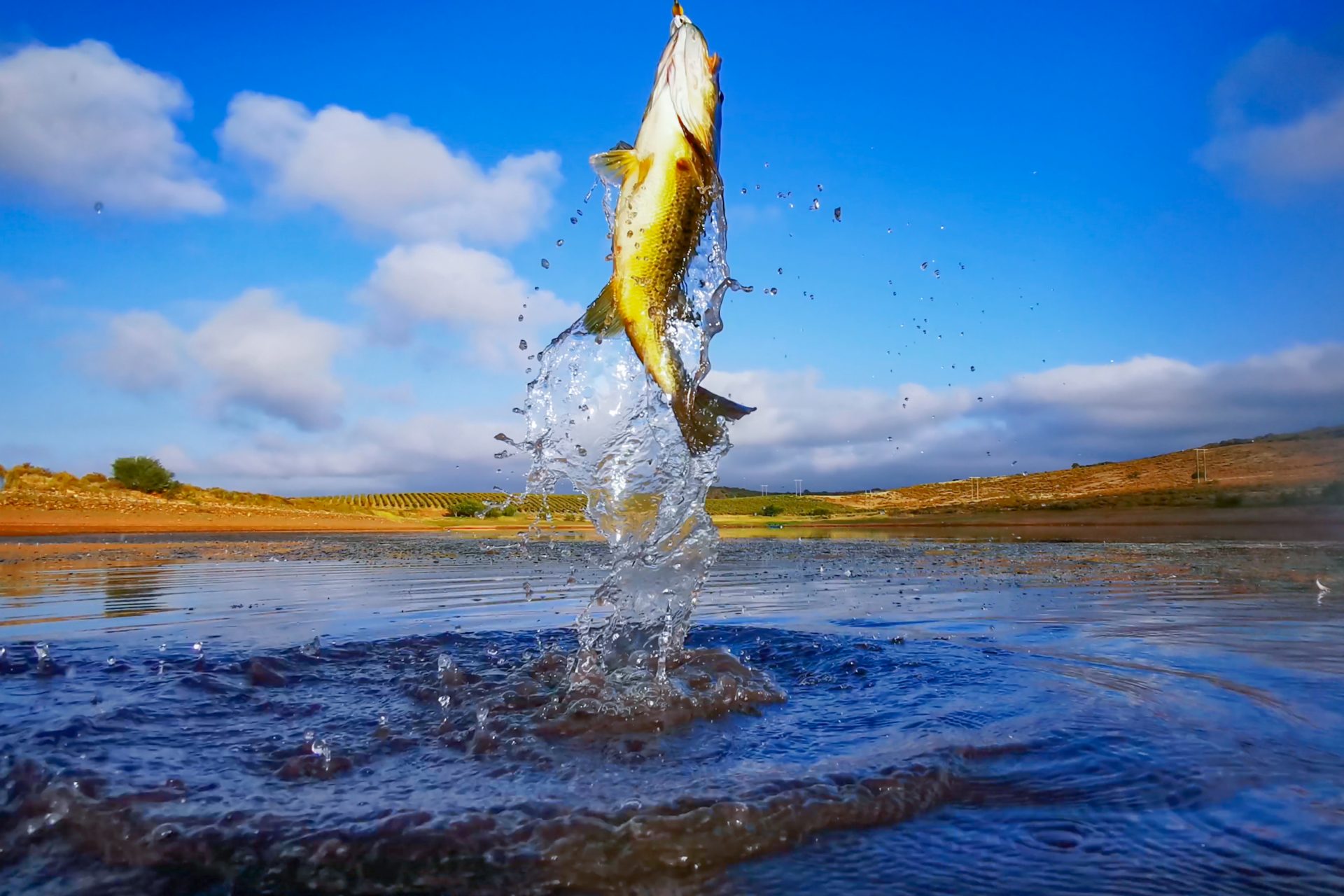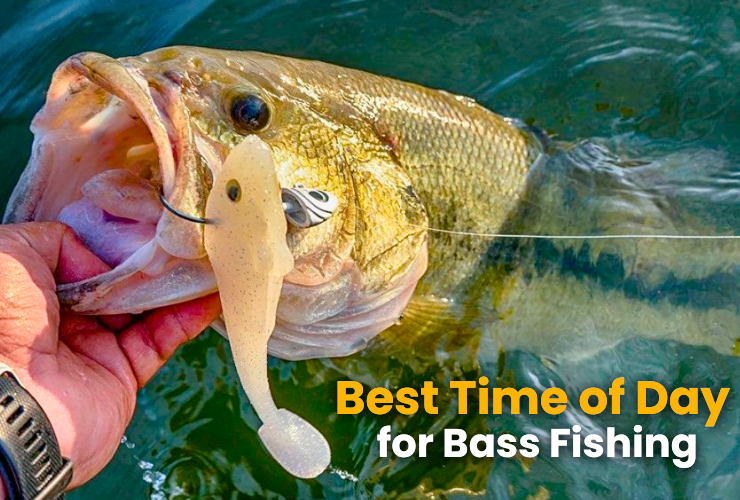How The Weather Affects Bass Fishing: Wind, Rain, and Temperature Explained
Share this bass fishing article with every angler you know!
All kinds of factors have to be taken into account when determining what the bite is going to be like.
The time of year, when bass are in their life cycle, the lures you have available, water clarity, the type of baitfish in the area, and all kinds of other things are crucial to hitting the water with the right strategy.
One of the biggest factors is the weather. There are a lot of misconceptions about it, and most anglers simplify it too much by only looking at the seasons.
Today, we’ll look closely at wind, rain, and temperature and explain how the weather affects bass fishing in different conditions.
Newsletter Signup
Weather’s Impact on Bass Fishing: The Basics of Bass Behavior
When anglers think about the weather and how it’s going to impact their time on the water, they usually think about their own comfort and safety.
Rarely does the average weekend warrior think about how temperature, wind, and rain will impact the behavior of bass.
It’s fair to take that approach, too. You’d think that the bass would be perfectly fine under the water. However, those weather conditions do affect the bass. They actually have a huge effect on the entire underwater ecosystem.
If you go out on the water one day and it’s still, but the next day there’s a decent breeze, bass behavior will change dramatically. Even if the temperature range is similar and there’s no precipitation.
Rain also has a dramatic impact on the water, and it’s not only noticeable when the rain is actively falling.
It’s crucial to understand how each weather condition will change the way bass behave below the surface if you want to go in with a solid strategy.
How Temperature Impacts Bass Behavior
This is what most anglers think of the most when they look at the weather. So, we’re going to start by tackling it.
Bass are cold-blooded. They rely on external factors to regulate their body temperature.
As such, they have to change their behavior dramatically depending on the temperature of their surroundings. Even small changes can have a big impact.
65 to 82 degrees is where a bass gets the most aggressive. For fishing, that’s exactly what you want. An aggressive bass is going to bite faster and harder without you having to put in too much work.
When you go below that temperature range, the bass get too cold, and they start looking for warmth.
They’ll move up and down in the column and get near heat sources before suspending in place. They have to rely on that to stay warm, and they’re not going to randomly swim off to attack a lure.
If the water temperature goes above that range, the bass get too hot. They will typically move to shaded areas where the temperature is lower, or they’ll dive deep and suspend until evening.
Usually, strategy adjustments can help you overcome stubborn bass if the temperature isn’t too far out of their peak range.
However, in the most extreme conditions, it can be extremely difficult to get a bite. That’s why only the most dedicated anglers tend to go bass fishing in the dead of winter or in hot, summer weather.
How Wind Affects Bass Behavior
Wind is bad for boat control, but great for Bass fishing.
In the book High Percentage Fishing, often referred to as the “Moneyball” of bass fishing, author Josh Alwine analyzed a database of more than 40,000 catches and found that bass catch rates were more than double the norm for winds over 15 mph. Here are 5 ways wind stimulates bass feeding:
Waves oxygenate the water, which creates a food chain reaction. Plankton rise in the water column, which attracts bait fish and bass.
Wave action scatters light, which disguises lures.
Wave action conceals fishermen, both visually and acoustically.
Wave action and wind can knock food into the water, such as insects, frogs, mice, and snakes.
Wind moves plankton and concentrates it in windblown areas. Plankton attracts baitfish, and baitfish attract bass.
“To find and catch more active bass, wind is one of the most important variables anglers need to consider,” says MLF angler Alton Jones Jr. “BassForecast is a quick, easy reference for me to view wind direction and speed 10 days into both the future and past.” Here are 3 ways you can use BassForecast wind data to plan your fishing tactics:
Once you know the wind direction, you can pre-scout windblown points and banks before you get on the water. Says Jones Jr., “As an apex predator, bass are going to be drawn to windblown areas because they offer bass an opportunity to locate and ambush big concentrations of baitfish.”
Tip: If the wind is blowing so hard that it is creating dangerous main lake boating conditions, look for a wind-protected area inside a wind-blown point to launch so that you don’t have to navigate treacherous waters to get there.
If the day you are fishing is calm (less than 5 mph wind), which can create very difficult fishing conditions, look at the past 10 days' wind direction on BassForecast by scrolling backward in the weather section
Tip: Fish points and banks the wind has been blowing into the past few days.
Regarding boat control, remember that bass usually feed facing into the wind. So, casting into the wind is the most productive presentation technique. You can use the wind to drift adjacent to the area you want to fish while throwing into and across the wind; a technique referred to as “quartering the wind.” If the wind is blowing you too fast, you can use a windsock to slow your drift, anchor, or use power poles.
How Rain Affects Bass Fishing
Rain can be both good and bad for bass fishing. It’s also one of the weather conditions that has an impact on bass behavior before and after you even see rain hitting the water.
You have to consider your own safety, deal with not being able to see as well, and also accept that it’s not the most comfortable situation to be in.
So, this is mostly something for the dedicated anglers who are willing to get out there in the rain to lip a big bass.
Before and after a rainstorm, the barometric pressure changes. You don’t really notice it, but the fish do.
Before a storm and sometimes immediately after, there’s typically a feeding frenzy, and the bass are extremely active. It’s the perfect time to bust out the fast-moving lures and start hooking into bass every cast.
When the rain actually hits, things change a bit. Bass can get very active during light rain. If you’re willing to deal with that, you can still catch lots of bass. Especially on hotter days when that light rain lowers the water temperature.
Heavy rain is a different story. It causes a lot of disruptions in the ecosystem, and you have to consider that it usually gets dangerous for you to be outside, too. If it’s pouring down, it’s almost always best to pack it up and wait it out.
Rain doesn’t just impact barometric pressure, safety, and temperature, though.
Bugs almost always swarm the surface of the water around weed lines before and after it rains, and that triggers some great topwater fishing.
Water clarity changes dramatically during the rain. Just like when the wind makes the water choppy, all those raindrops do the same thing. They make it harder for light to penetrate the water, and clarity is dramatically lowered.
On top of the water lowering clarity, you have to consider the runoff that occurs. Rain washes dirt from the shore into the water, and even relatively clear lakes tend to be a bit stained after it rains.
You’ll have to adjust your strategy accordingly.
How to Adjust Your Fishing Strategy to Different Weather Conditions
It’s nice to know how the weather affects bass fishing and your overall experience, but if you don’t know how to adjust your strategy, it doesn’t help you catch more fish.
The team at Bass Forecast wants to help you catch big bass year-round. So, we’re going to go over some of our favorite tips for adjusting to the weather.
1: Change Your Depth
Temperature is a major player. Whether it’s simply the temperature of the day or if the wind and rain cause a sudden drop, the bass respond to it.
If the bass have been hiding from the heat all day, they’re likely to move up when the water cools due to wind or rain. If it’s cold, they’ll likely move even deeper to avoid that temperature drop.
In any case, you want to change the depth you’re fishing at to target the part of the column that the bass are likely to be in.
You won’t catch bass by fishing at the top if they’re suspending deep in the column to stay warm, and they’re not likely to move far out of their comfort zone to get lures that are a few feet out of their preferred spot.
2: Go for Hi-Vis Lures
Two out of three of the weather conditions we talked about cause water clarity to drop dramatically. Even if you’re in a clear body of water.
As such, you’ll want to change your lure to account for that lack of water clarity and choose the right color to attract the bass.
White and chartreuse are our two favorite colors for low-clarity water, and if you get a combo color that adds black or blue to the mix, it’s bound to be a killer setup.
3: Change Up Your Retrieval and Pace
Presentation techniques also have an important role. If the conditions are going to send the bass into a frenzy, you want to speed up your presentation. The bass are more active, and so are the baitfish. So, you want to make your lure match the level of activity.
If the bass are in conditions that are going to slow them down or make them stubborn, you want to slow your presentation down. Choose a retrieval pattern with lots of pauses, hop the bottom slowly, or completely dead stick your rod.
4: Have a Variety of Tackle Available
These conditions can change at a moment’s notice during any season, and they’ll likely force you to change your approach to fishing. As such, you want to make sure you have plenty of tackle options to match the conditions throughout the day.
It’s not good enough to look at the forecast before you head out, grab lures for one specific type of weather, and hope it works all day. You want to be ready to adapt.
5: Safety First
We often mention that going into the less comfortable or extreme conditions is something the pros do. The Bass Master Classic is in winter, and hardcore anglers will stay out in the rain or high winds, etc.
In any case, it’s always best to acknowledge when the weather is too much and just pack it up. You can head to your vehicle and wait it out, or there’s always another day.
It’s certainly not worth pushing yourself beyond reasonable conditions and ending up hurt or worse.
What are the Best Conditions for Bass Fishing?
We’ve talked about how the weather affects bass fishing, but what is considered ideal bass fishing weather? When are you most likely to catch bass back-to-back and have a great day?
Well, that’s usually going to be when there’s no wind, the temperature is about 65 degrees, and a rainstorm is on the way. It’s even better if you get these conditions in late spring or early summer when the bass are extremely active.
The hour or two before the storm rolls in is going to be full of action. The fish know it is coming, which can create feeding frenzies, and the other weather conditions are optimal. If you’re out on the lake or able to get there fast enough, you’re in for a treat.
Although we highly recommend getting on the water even when conditions aren’t optimal. Those experiences help you become a better angler, and you know what they say.
Even the worst day of fishing is better than your best day at work. So, it’s okay if everything isn’t perfect.
Time Your Next Fishing Trip Right and Catch Some Big Bass
If you use these tips to time your next fishing trip, you can have a great day on the water. If you’re a more dedicated angler who is going to fish in bad conditions for the fun of it, these tips will help you adjust.
For more help, download our bass fishing app, get out there, and catch your next personal best!



.gif)
.jpg)




.png)
.png)